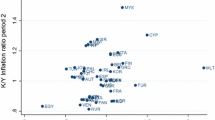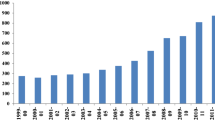Abstract
This paper provides a link between long-standing labor demand elasticity estimates in U.S. manufacturing and recent studies of wage patterns and labor demand shifts in response to technical change and international trade. We document asymmetric changes in labor demand elasticities including an absolute and relative increase in own-wage elasticity of demand for production workers. Separate estimates of substitution and scale responses imply that skill-biased technical change dominates increased product market competition as a source of the observed changes in labor demand elasticity.
Similar content being viewed by others
References
Amiti, M., & Wei, S.-J. (2005). Fear of service outsourcing: is it justified? Economic Policy, 20(42), 309–347.
Bartelsman, E., Becker, R., & Gray, W. (2000). National Bureau of Economic Research—Center for Economic Studies manufacturing industry data base, 1958–1996. Boston: NBER.
Berman, E., Bound, J., & Griliches, Z. (1994). Changes in the demand for skilled labor within U.S. manufacturing: evidence from the annual survey of manufacturers. Quarterly Journal of Economics, 109(2), 367–397.
Clark, K., & Freeman, R. (1980). How elastic is the demand for labor? Review of Economics and Statistics, 62(4), 509–520.
Feenstra, R., & Hanson, G. (1999). The impact of outsourcing and high-technology capital on wages: estimates for the United States, 1979–1990. Quarterly Journal of Economics, 114(3), 907–940.
Feenstra, R., Romalis, J., & Schott, P. (2002). U.S. imports, exports and tariff data. National Bureau of Economic Research Working Paper #9387. Boston: NBER.
Griliches, Z. (1969). Capital-skill complementarity. Review of Economics and Statistics, 51(4), 465–468.
Hamermesh, D. (1993). Labor demand (pp. 17–136). Princeton: Princeton University Press.
Haskel, J. (2000). Trade and labor approaches to wage inequality. Review of International Economics, 8(3), 397–408.
Hirsch, B. (2004). What do unions do for economic performance? Journal of Labor Research, 25(3), 415–455.
Hirsch, B., & Schumacher, E. (2001). Private sector union density and the wage premium: past, present and future. Journal of Labor Research, 22(3), 487–518.
Kaufman, B. (2004). What do unions do: insights from economic theory. Journal of Labor Research, 25(3), 351–382.
Kesselman, J., Williamson, S., & Berndt, E. (1977). Tax credits for employment rather than investment. American Economic Review, 67(3), 339–349.
McKinnon, R. (1962). Wages, capital costs and employment in manufacturing. Econometrica, 30(3), 501–521.
Morrison, C., & Siegel, D. (2001). The impacts of technology, trade and outsourcing on employment and labor composition. Scandinavian Journal of Economics, 103(2), 241–264.
Nadiri, M. (1968). The effect of relative prices and capacity on the demand for labor in the U.S. manufacturing sector. Review of Economic Studies, 35(3), 273–288.
Ravenga, A. (1992). Exporting jobs? The impact of import competition on employment and wages in U.S. manufacturing. Quarterly Journal of Economics, 107(1), 255–284.
Rich, D. (1990). On the elasticity of labor demand. Quarterly Review of Economics and Business, 30(3), 31–41.
Shippen, Ben, Jr. (1999). Labor market effects of import competition: theory and evidence from the textile and apparel industries. Atlantic Economic Journal, 27(2), 193–200.
Slaughter, M. (2001). International trade and labor demand elasticities. Journal of International Economics, 54(1), 27–56.
Author information
Authors and Affiliations
Corresponding author
Rights and permissions
About this article
Cite this article
Rich, D.P. Changing Elasticities of Labor Demand in U.S. Manufacturing. Atl Econ J 38, 157–168 (2010). https://doi.org/10.1007/s11293-010-9223-5
Published:
Issue Date:
DOI: https://doi.org/10.1007/s11293-010-9223-5




